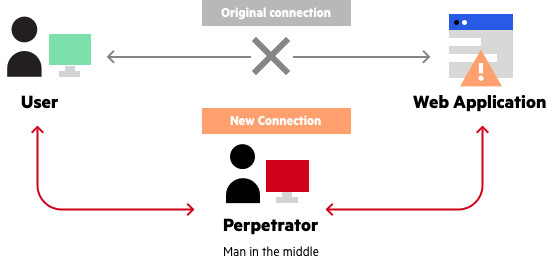What is Man in The Middle Attack and How to Prevent it?
Attackers these days utilize a variety of security threats to take advantage of vulnerable applications. And the man in the middle attack is an example of the same.
Threat actors use automated software to carry out these attacks, while others necessitate a more active engagement on their part.
So, to make you familiar with this kind of cyberattack, we’re going to discuss the same in detail.
Man in the Middle Attack – A Brief Introduction
Man In The Middle or, in short, MITM attacks involve three players. The attacker, the sending-end and receiving-end victims. Yes, there are two victims.
Basically, the attackers eavesdrop on an existing conversation or data transfer. The intruders insert themselves in the ‘middle’ of the conversation or transfer and pretend to be both legitimate participants.
A MITM attack tries to convince the victim to take on certain activities, including updating their login information, completing a transaction, or beginning a money transfer, at the same time they also collect personal information, financial information, or passwords from them.
Different Types of Man in the Middle Attack
There are several different ways by which threat actors can easily obtain the user’s sensitive information.
- IP spoofing: – cybercriminals spoof entities and the internet protocol address of websites, devices, or email addresses of trusted sources to steal the users’ information. The main concern is that the users provide their information to a malicious actor without realizing the same.
- HTTPS spoofing: – A user presumes that a website has HTTPS, which means that the website host will get their computer data secured. However, they were covertly diverted to an insecure HTTP website, giving attackers the opportunity to monitor interactions and take data.
- SSL hijacking: – Hijacking the Secure Sockets Layers (SSL) is an extension of HTTPS spoofing, and it occurs when a hacker uses the protocol that encrypts HTTPS connections to steal user data as it travels between the client and the server they are talking to.
- Email hijacking: – In this type of man in the middle attack, attackers steal information and monitor transactions by gaining covert access to a bank or credit card company’s email accounts. They might even provide customers misleading instructions. Such as depositing money into a new checking account, by using an email account or a fake email address that is somewhat different from the real one.
- DNS spoofing: – In order to obtain user passwords or other information, a spammer engages in Domain Name System (DNS) spoofing. They do the same by building and running a bogus website that seems authentic and directs users there.
- Wi-Fi eavesdropping: – Spammers create hotspots or public Wi-Fi networks that resemble local businesses or other reliable sources. All user activity and private information are then intercepted when users connect.
- Session hijacking: – cybercriminals steal passwords stored on web browser cookies. Session hijacking is also known as web browser cookie theft.
How Cybercriminals Execute Man in the Middle Attack?
Mainly MITM attacks are executed in phases by the intruders. Let’s discuss the same in points.
- Through an unprotected or inadequately protected Wi-Fi router and/or by tricking domain name system (DNS) servers, cybercriminals can enter a network. Then, attackers probe the router for openings and potential vulnerabilities. Attackers use more sophisticated techniques like IP spoofing or cache poisoning, but the most common way to achieve this is by using a weak password.
- Once a target has been found, the attacker often uses data collection tools to access and collect the victim’s sensitive data, purposefully reroute traffic, or otherwise influence the user’s web experience.
- At this point, cybercriminals can decode and comprehend the stolen data. However, decrypted data may be used for a range of illegal acts, including identity theft, shady shopping, and fraudulent financial transactions. Man-in-the-middle attacks can occasionally be carried out for no apparent reason other than to sabotage business processes and create chaos for victims.
Prevention Techniques of Man in the Middle Attacks
Now as we know what a man-in-the-middle attack is and how it works. Let’s move forward and discuss the preventive measures so that you can keep yourself safe from these kinds of attacks.
- Avoid using public networks.
- Use a virtual private network (VPN) to stay secure.
- Use a two-factor authentication method.
- Educate your employee about these kinds of attacks.
- Make sure you conduct regular audits and monitor your network
- For internal use, guest use, and data transfers for corporate applications, create distinct wifi networks.
- Use SSL/TLS to encrypt your emails. Additionally, you can think about PGP/GPG encryption as well.
- To secure sensitive online transactions, use browser plugins like ForceTLS or HTTPS Everywhere.
- Install intrusion detection systems with the latest technologies.
- Use chrome, firefox, safari, and internet explorer to maintain high security.
Conclusion
The way rates of cyber threats are rising, not just individuals but businesses are also facing data security threats. And, most of the time, attackers use employees as baits to carry out such malicious activities. So, it’s necessary to make sure that your organization’s staff is educated on all kinds of cyberattacks including man in the middle attack.
In case you want to opt for cyber awareness training programs, you can consult with Anuraag Singh who has 15+ years of experience in the field of cybersecurity.
